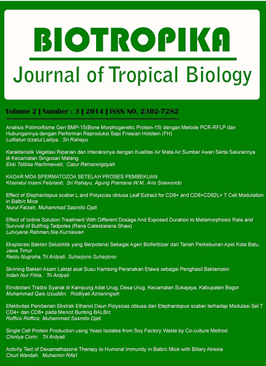Eksplorasi Bakteri Selulolitik yang Berpotensi Sebagai Agen Biofertilizer dari Tanah Perkebunan Apel Kota Batu, Jawa Timur
Abstract
Biofertilizer adalah pupuk yang berasal dari biomassa berbagai mikroorganisme tanah, berfungsi sebagai penyedia hara dalam tanah, sehingga mudah diserap oleh tanaman. Bakteri selulolitik telah banyak dimanfaatkan sebagai salah satu agen biofertilizer. Penelitian ini bertujuan untuk menguji aktivitas bakteri selulolitik yang berasal dari tanah perkebunan apel di Kota Batu, Jawa Timur yang berpotensi sebagai biofertilizer didasarkan pada kemampuan selulolitik, fiksasi nitrogen, dan pelarut fosfat. Sampel tanah diambil dari tanah perkebunan apel yang terletak di Dusun Junggo, Desa Tulungrejo, Kecamatan Bumiaji, Kota Batu. Isolasi dilakukan dengan metode serial dilution kemudian ditumbuhkan pada media C-NFMM (Cellulose Nitrogen Free Mineral Media) agar. Uji aktivitas selulolitik isolat bakteri menggunakan pewarnaan Congo red 0,1% yang ditandai dengan terbentuknya zona bening. Uji kuantitatif aktivitas selulolitik dilakukan dengan DNS (dinitrosaly-cylic acid). Uji kemampuan pemfiksasi nitrogen menggunakan media N-Free Semisolid Malate dilanjutkan dengan Visocolor Alpha Ammonium Detection Kit. Deteksi aktivitas pelarut fosfat menggunakan media Pikovskaya agar. Hasil isolasi didapatkan 13 isolat kemudian dilakukan screening hingga didapatkan 3 isolat bakteri yang potensial, yaitu isolat SL4, SL5, dan SL7. Aktivitas selulolitik tertinggi adalah isolat SL4 pada jam ke-24 yaitu sebesar 0,05 ± 0,002 U/ml, sedangkan isolat SL7 pada jam ke-72 sebesar 0,05 ± 0,001 U/ml. Uji potensi sebagai agen biofertilizer berdasarkan kemampuan selulolitik, pemfiksasi nitrogen, dan pelarut fosfat didapatkan 3 isolat potensial yaitu SL4, SL5, dan SL7.
Kata kunci : biofertilizer, fosfat, nitrogen, selulolitik, tanah
References
Simanungkalit, R.D.M., D.A. Suriadikarta., R. Saraswati., D. Setyorini & W. Hartatik. 2006. Pupuk Organik dan Pupuk hayati. Balai Besar Penelitian dan Pengembangan Sumberdaya Lahan Pertanian. Bogor.
Ibrahim, A.S.S., & El-diwany. 2007. Isolation and identification of new cellulases producing thermophilic bacteria from an Egyptian hot spring and some properties of the crude enzyme. J Appl Sci 1:473-478.
Steensma, D.P. 2001. Congo red out of Africa: archives of pathology and laboratory medicine 125:250-252.
Sumardi. 2004. Isolasi, Karakterisasi, dan Produksi β-mananase Ekstraseluler dari Geobacillusstrearothermophilus. Program Pascasarjana, Institut Pertanian Bogor. Bogor.
Mulyadi, M., Wuryanti & P.S. Ria. 2013. Konsentrasi Hambat Minimum (KHM) Kadar Sampel Alang-Alang (Imperata cylindrica) dalam Etanol melalui Metode Difusi Cakram. Universitas Diponegoro, Kimia. Semarang.
Apun, K., B.C. Jong & M.A. Salleh. 2000. Screening and Isolation of A Cellulolytic and Amylolytic Bacillus from Sago Pith Waste. J. Gen. Appl. Microbiol. 46: 263-267.
Garg, S.K. & Neelakantan. 1982. Effect of Nutritional Factors on Cellulase Enzyme and Microbial Protein Production by Aspergillus terreus and Its Evaluation. Dairy Microbiology Division, National Dairy Research Institute. India.
Jarallah, E. M. & Ali. 2013. Cellulolytic Activity of Cellvibrio japonicus and Complete Cellulase System. Biology Department, College of Science, University of Babylon. Iraq.
Harran, S. & N. Ansori. 1992. Bioteknologi Pertanian. Bogor. Pusat Antar Universitas Bioteknologi. Institut Pertanian Bogor. Bogor.
Purwaningsih, S. 2003. Isolasi, Populasi, dan Karakterisasi Bakteri Pelarut Fosfat pada Tanah dari Taman Nasional Bogani Nani Wartabone. Sulawesi Utara.
Rachmiati, Y. 1995. Bakteri Pelarut Fosfat dari Rizozfer Tanaman dan Kemampuannya dalam Melarutkan Fosfat. Proseding Kongres Nasional VI HITI. Jakarta.
Downloads
Published
Issue
Section
License
Copyright and Attribution:
Articles in Biotropika: Journal of Tropical Biology are under Creative Commons Attribution-NonCommercial (CC-BY-NC) copyright. The work has not been published before (except in the form of an abstract or part of a published lecture or thesis) and it is not under consideration for publication elsewhere. When the manuscript is accepted for publication in this journal, the authors agree to the automatic transfer of the copyright to the publisher.
![]() Journal of Biotropika: Journal of Tropical Biology is licensed under a Creative Commons Attribution-NonCommercial 4.0 International (CC BY-NC 4.0).
Journal of Biotropika: Journal of Tropical Biology is licensed under a Creative Commons Attribution-NonCommercial 4.0 International (CC BY-NC 4.0).
Permissions:
Authors wishing to include figures, tables, or text passages that have already been published elsewhere and by other authors are required to obtain permission from the copyright owner(s) for both the print and online format and to include evidence that such permission has been granted when submitting their papers. Any material received without such evidence will be assumed to originate from one of the authors.
Ethical matters:
Experiments with animals or involving human patients must have had prior approval from the appropriate ethics committee. A statement to this effect should be provided within the text at the appropriate place. Experiments involving plants or microorganisms taken from countries other than the author's own must have had the correct authorization for this exportation.

















